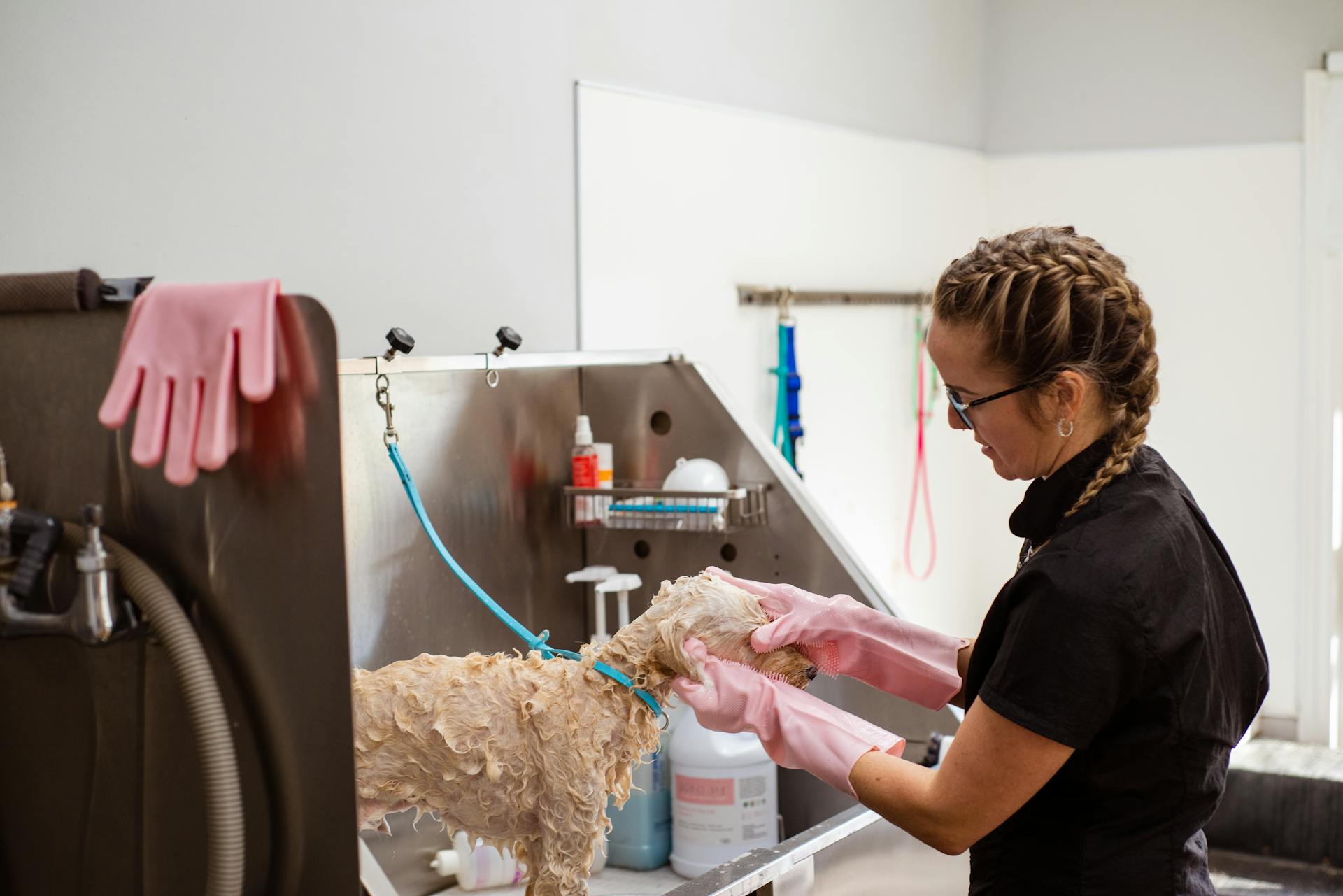
Dog platform training is a fantastic way to help your furry friend feel more confident and secure. By teaching your dog to comfortably walk on a platform, you can prevent jumping and other unwanted behaviors.
A platform trainer is a great tool for this type of training, as it allows your dog to get used to standing on a raised surface. In fact, platforms can be as simple as a flat board or as complex as a multi-level system.
Some dogs may take to platform training right away, while others may need more time and patience. It's essential to go at your dog's pace and not rush the training process.
With consistent practice and positive reinforcement, your dog can learn to walk calmly and confidently on a platform.
What Is Dog Platform Training?
Dog platform training is a specialized type of training where you teach your dog to stay still on an elevated platform, placemat, or bed while waiting for commands.
This type of training is also known as place training, and elevated platforms are preferred because they help your dog stay still.
The training process starts by rewarding your dog with treats and praise for getting onto the platform and staying on it.
Lower platforms are preferred at first while your dog acclimates, and then you slowly increase the height over time.
At its core, platform training helps your dog know what's expected of them during training and helps them enter a more calm, trainable mindset.
Platform training is useful for hyperactive dogs that require focused guidance to "get it" and can also help weed out undesirable problem behaviors like barking, chewing, or digging.
The elevated edge of the platform keeps your dog in place long enough for you to engage them with training, which starts with basic obedience like "sit" and "stay".
Platform training can be used to teach more advanced techniques, like agility or directional commands, once the foundations are laid.
A unique perspective: Dog Place Training Mat
Getting Started
You can use a variety of things around the home as a dog training platform, like an old coffee table or a durable box.
Non-slip surfaces are essential, so your pup doesn't slide across it.
One of the best cues to start with is "attention", which means having your dog stand right in front of you, looking at you, being calm, and waiting for a cue.
Training your dog to give their attention by standing in front of you is an essential skill that will make future training much easier.
Rewarding your dog with a high-value treat at a high rate of reinforcement can help them understand that giving their attention is a good thing.
Benefits and Advantages
Stationing your dog on a platform is a game-changer for their training. It can facilitate a calm and controlled environment, which is essential for their growth and development.
This calm environment helps dogs keep their attention and focus, which is crucial for learning new skills. By keeping their attention, you can teach them to be more patient and composed in various situations.
Using a platform for training gives you, as the trainer, the opportunity to hit the reset button if things aren't going as planned. This flexibility is invaluable in dog training, where unexpected situations can arise at any moment.
What Are the Benefits of?
Platform dog training can facilitate a calm and controlled environment, helping dogs keep attention and focus.
Stationing on a platform is a game-changer for dog training, allowing you to hit the reset button if things aren't going as planned.
Platform training can help dogs learn patience, which is an essential life skill.
By using a platform, you can shape a more well-rounded and capable dog.
Platform dog training has a number of impressive upsides that make them worth using for a lot of people.
The results of platform training are all aimed at helping your dog become a more confident and capable companion.
Expand your knowledge: Do Dog Shock Collars Work
Builds Focus
Platform training is a game-changer for building focus in dogs. Regular platform training helps your dog build their focus and attention span over time.
Initially, your dog won't be able to concentrate on training for very long at a time, making short but frequent sessions important. This is because platform training allows dogs to enter training mode as soon as they jump onto the platform, preparing them for what's coming.
Broaden your view: All about Dogs Dog Training

As your dog becomes more comfortable with platform training, you can slowly ramp up the training when you notice their capacity for listening for longer periods increases. This is a sign that their focus is improving.
By building focus, platform training also helps dogs learn patience, which is essential for behaving well when not training.
Expand your knowledge: Focus Dog Training
Challenges and Limitations
Dog platform training can be challenging, especially for inexperienced trainers.
The main challenge is maintaining a consistent and steady pace, which is crucial for platform training. This can be difficult for some dogs, especially those with high energy levels.
Some dogs may also struggle with the concept of stepping up onto the platform, requiring patience and repetition to overcome.
A common limitation of platform training is the need for a large, open space to set up the platform.
Discover more: Is Crate Training Good for Puppies
The 3 Disadvantages
One of the main challenges with platform training is that it can be limited in its applications. Your dog may only learn to perform commands while on their platform, which doesn't always translate to real-life situations.

This can lead to difficulties in obedience, even for well-trained dogs. They may not obey all commands off the platform, as seen in dogs that are "obedient angels" while on it.
Slow generalization training can help alleviate this issue, but it's not a guarantee. Some dogs may still struggle to generalize their learning to new situations.
Can Be Boring
Some trainers fall into a repetitive cycle while using a platform, making it boring for their dog. This can lead to a lack of engagement and progress in training.
Dogs that don't tolerate platform training well often do so because the trainers fail to make it exciting. The trainers might be using the platform exactly as instructed without adding any fun elements.
Mixing in fun games can help engage your dog's creative side and make platform training more enjoyable. This approach can help prevent boredom and make the training process more effective.
Suggestion: E Collar Dog Trainers
Expert Approach and Additional Tools
Platform training requires a specific and experienced approach, especially for first-time dog owners. Seasoned trainers know how to tailor the process to fit a dog's unique personality and quirks.
You can't just wing it with platform training, and that's why hiring a dog trainer can be a good idea, even if it's not cheap. They'll help you navigate the process and ensure you're doing it right.
To enhance your platform training, you can use tools like clickers and target sticks, which are great for producing specific results. Leashes are also a must-have, as they help translate your training to outdoor situations.
Check this out: Do Dog Diapers Help with Potty Training
Requires Expert Approach
Platform training requires a specific and experienced approach, especially for first-time dog owners. It's tricky to tailor the process to fit a dog's unique personality and quirks.
Seasoned trainers know how to navigate this challenge, but it's not something you can easily learn at home. That's why it's not cheap to hire a dog trainer to help you with the process.
With the right guidance, you can learn to adapt platform training to your dog's needs, but it does take expertise.
Is Clicker Training?
Clicker training is a distinct training technique that uses a clicker to mark the exact moment your dog does something correctly and tells them to expect a reward.
Clicker training is very successful when used correctly. It's easy to muddle up if you're new to dog training, though.
Here's an interesting read: Dog Clicker Training App
Behavior Modification
Behavior modification is a key aspect of platform training, helping to reduce unwanted behaviors in your dog. By giving your dog a safe space associated with calmness and security, you can redirect behaviors like jumping on guests to a safe bed or mat.
Platforms can also be used to desensitize dogs that develop fears of ordinary objects, reversing fear responses and turning them into positive associations. This is achieved through positive reinforcement techniques.
Impulse control can be a challenge, but with the right tools and techniques, you can teach your dog to behave. Leashes, for example, are a useful tool in translating your training to outdoor leashed situations.
Repetition and practicing commands in different places and situations, also known as proofing, can help solidify your dog's understanding of what you want them to do. This can be especially helpful when teaching multi-step commands like "roll over" and "play dead."
Discover more: Positive Dog Training
Frequently Asked Questions
How do you train a dog to stand on a platform?
To train a dog to stand on a platform, start with a low height and gradually increase it while praising your dog for their progress. With patience and positive reinforcement, your dog will learn to comfortably stand on the platform.
What size should a dog training platform be?
For effective dog training, a platform should be 10 inches wide, allowing about ½ inch of space on each side of your dog when they're sitting on it. This size ensures precision training and helps your dog learn quickly.
Sources
- https://www.thewildest.com/dog-behavior/platform-dog-training
- https://www.whole-dog-journal.com/lifestyle/what-is-a-dog-training-platform/
- https://www.dogster.com/dog-training/dog-platform-training
- https://teamunrulyblog.wordpress.com/2014/06/20/k9diy-make-your-own-dog-training-platform/
- https://canineconditioningcoach.com/platforms-in-canine-fitness-part-3-building/
Featured Images: pexels.com


